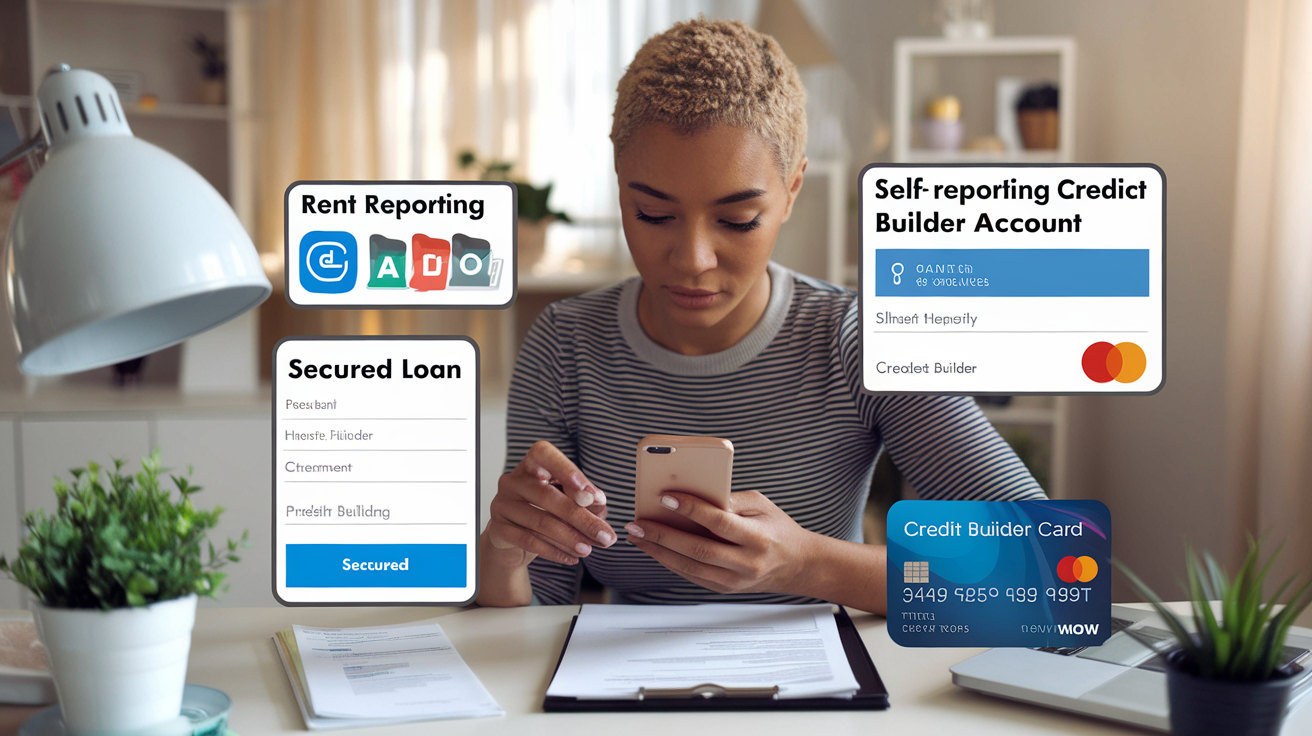How to Build Credit Fast in the USA: The Ultimate Guide for Beginners

Ever walked into a room where everyone’s speaking credit score, and you’re just nodding along, totally lost? You’re not alone. Nearly 1 in 5 Americans have no credit score at all, and they’re paying for it every month with higher interest rates and security deposits.
Here’s the truth: building credit fast in the USA isn’t rocket science, but nobody hands you the manual when you turn 18.
I’ve helped hundreds of credit newbies go from zero to 700+ in under a year. The strategies aren’t complicated, but they are specific. And the difference between knowing them and not? Thousands of dollars over your lifetime.
So what’s the fastest path to good credit that doesn’t involve any sketchy “credit repair” nonsense? It starts with understanding one crucial principle most “experts” never mention…
Understanding Credit Fundamentals

How Credit Scores Work in the USA
Credit scores in the USA aren’t just random numbers – they’re calculated using specific information from your credit history. The most common scoring model is FICO, which ranges from 300 to 850. Your score is built from five key factors:
-
Payment history (35%): Do you pay bills on time?
-
Credit utilization (30%): How much of your available credit are you using?
-
Length of credit history (15%): How long have you had credit accounts?
-
Credit mix (10%): Do you have different types of credit?
-
New credit (10%): How many recent applications have you made?
A good score (700+) doesn’t happen overnight. Most lenders consider anything above 670 as “good,” while 740+ is “very good,” and 800+ is “excellent.”
The Major Credit Bureaus: Experian, Equifax, and TransUnion
The three major credit bureaus collect your financial data and create your credit reports. Each might have slightly different information because not all lenders report to all bureaus.
These companies track:
-
Your payment history
-
Outstanding debts
-
Credit applications
-
Public records like bankruptcies
You’re entitled to one free credit report from each bureau annually through AnnualCreditReport.com. Smart move? Check a different bureau every four months to monitor your credit year-round.
Why Good Credit Matters for Your Financial Future
Good credit isn’t just about getting approved for a credit card. It affects nearly every financial aspect of your life:
-
Lower interest rates on loans and mortgages (saving you thousands)
-
Better insurance premiums
-
Easier apartment approvals
-
More negotiating power with lenders
-
Employment opportunities (some employers check credit)
Bad credit can cost you big time. The difference between a 650 and 750 score on a $300,000 30-year mortgage could mean paying an extra $30,000+ in interest.
Setting Realistic Timeframes for Credit Building
Building credit takes patience. Here’s what to expect:
-
1-3 months: Establish initial accounts, see your first credit score
-
6 months: Develop a FICO score (requires at least six months of credit history)
-
1-2 years: Build a solid foundation with regular on-time payments
-
2+ years: Reach “good” credit territory if you’re consistent
Starting from scratch? You might hit 700+ in about two years of perfect behavior. Recovering from mistakes like late payments or collections? That could take 2-7 years, depending on the severity.
The credit-building journey isn’t a sprint – it’s a marathon. Small, consistent steps are more important than quick fixes.
Secure Your First Credit Building Tools

Starter Credit Cards for Beginners
Looking to build credit from scratch? Starter credit cards are your best friend. These cards are specifically designed for people with little to no credit history.
Capital One Platinum Secured and Discover it® Student Cash Back are solid options that don’t require excellent credit scores. Many offer pre-qualification, which lets you check if you’re likely to be approved without a hard inquiry hitting your credit report.
The catch? Higher interest rates and lower credit limits. But that’s totally fine when you’re just starting out—especially if you pay your balance in full each month.
Secured Credit Cards: Your Gateway to Credit
Secured cards are the training wheels of the credit world. You put down a deposit (usually $200-$500) that becomes your credit limit.
The beauty of secured cards? Almost guaranteed approval, even with no credit history. Plus, most card issuers report to all three major credit bureaus, helping you build credit fast.
After 6-12 months of responsible use, many issuers will return your deposit and upgrade you to a traditional unsecured card. The Secured Mastercard® from Capital One and Discover it® Secured are top picks with minimal fees.
Become an Authorized User on Someone Else’s Account
Want a credit shortcut? Ask a family member or close friend with good credit to add you as an authorized user on their card.
This strategy is brilliant because their account history gets copied to your credit report. Instant credit history boost!
A few things to keep clear:
-
The primary cardholder remains responsible for payments
-
Make sure they have a solid payment history
-
Confirm the card issuer reports authorized users to credit bureaus
Credit Builder Loans: A Hidden Gem
Credit builder loans flip traditional loans upside down. The “loan” amount goes into a locked savings account while you make monthly payments. Once you’ve paid in full, you get the money.
These loans are perfect for total beginners since approval doesn’t depend on your credit score. Self and Credit Strong offer affordable options with payments as low as $25/month.
Every payment builds your credit history and boosts your score over time.
Store Credit Cards: Pros and Cons
Retail store cards can be easier to qualify for than traditional credit cards, making them tempting for beginners.
The good stuff: instant discounts, rewards on store purchases, and generally easier approval. The Target RedCard™ and Amazon Store Card are popular starter options.
The downside? Sky-high interest rates (often 25%+), low credit limits, and limited usability outside that specific retailer.
Only go this route if you shop frequently at that store and can commit to paying your balance in full every month. Otherwise, the tempting discounts will cost you way more in interest charges.
Mastering Credit Card Usage for Maximum Impact

The Perfect Credit Utilization Ratio
Credit utilization is that magic number that can make or break your credit score. It’s simply how much of your available credit you’re using. The sweet spot? Keep it under 30%. But honestly, under 10% is even better.
Here’s what happens to your score at different utilization levels:
| Utilization | Impact on Credit Score |
|---|---|
| Under 10% | Maximum benefit |
| 10-30% | Positive impact |
| 30-50% | Begins to hurt score |
| Over 50% | Significant damage |
The trick most people miss? Your utilization is reported on your statement closing date, not your due date. So even if you pay in full each month, high balances can still hurt your score if they’re reported before you pay.
Payment Timing Strategies That Boost Scores
Timing is everything with credit card payments. Making the minimum payment on time is just the baseline—not the goal.
Want to supercharge your credit building? Try these power moves:
-
Pay twice monthly instead of once
-
Make payments before your statement closes
-
Set up automatic payments to never miss a due date
-
Make small payments whenever you have extra cash
Credit scoring models love seeing consistent, early payments. They show you’re responsible and not stretching your finances thin.
Avoiding Common Credit Card Mistakes
Even tiny slip-ups can undo months of careful credit building. These mistakes can tank your score fast:
-
Missing payments by even a single day
-
Closing old credit cards (kills your credit history length)
-
Applying for multiple cards in a short period
-
Maxing out cards, even temporarily
-
Only making minimum payments month after month
The biggest blunder? Thinking all credit cards are created equal. They’re not. Cards with high fees, sky-high interest rates, and no grace period can trap you in debt cycles that destroy your credit.
Instead, choose cards with no annual fee while building credit, and always read the fine print before applying.
Beyond Credit Cards: Alternative Credit Building Methods

A. Rent Reporting Services That Count Toward Credit
Guess what? Your rent payments can boost your credit score! Yep, those monthly checks you’re writing anyway can help build your credit history. Services like Rental Kharma, RentTrack, and Piñata report your on-time rent payments to credit bureaus. The cost? Usually between $5-$10 monthly, but that’s pocket change compared to what you’re getting back in credit-building power.
Some landlords already work with these services, so ask yours if they’re reporting your payments. If not, sign up on your own. Most of these services also report your payment history retroactively, giving your score a quick bump.
B. Utility and Phone Bill Reporting Options
Your regular bills can work harder for you! Experian Boost lets you link your bank account so they can track utility and phone payments. The best part? It’s free and can add points to your score instantly.
Other options include:
-
eCredable: Tracks utility payments
-
SimpleBills: Reports roommate utilities
-
Self: Offers utility bill reporting as part of their program
Just remember, these services only report to specific bureaus, so your scores might improve unevenly across Experian, TransUnion, and Equifax.
C. Self-Lender and Other Credit-Building Programs
Self (formerly Self-Lender) offers one of the smartest approaches to building credit. Here’s how it works: you make monthly payments to yourself. Yes, you read that right.
You open a “credit-builder loan” where your payments go into a certificate of deposit (CD). When the loan term ends (typically 12-24 months), you get your money back minus fees. The cool thing? Those payments get reported to all three credit bureaus.
Other similar programs include:
-
Credit Strong: Offers longer terms up to 10 years
-
MoneyLion: Combines credit building with cash advances
-
SeedFi: Helps build credit and savings simultaneously
D. Using Small Personal Loans Strategically
Small personal loans can be credit-building powerhouses if used right. I’m talking about $500-$1,000 loans from credit unions or community banks.
The strategy? Borrow a small amount, put the money in a separate account, and use it only to make payments on the loan itself. You’re essentially paying to build credit, but the investment pays off when you qualify for better rates later.
Some tips:
-
Check that the lender reports to all three bureaus
-
Set up autopay to avoid missing payments
-
Compare interest rates and fees before applying
-
Consider secured loans if your credit is particularly limited
Credit unions often offer “credit builder loans” with lower interest rates than traditional personal loans.
Monitoring and Protecting Your Growing Credit

Free Credit Report Access: Your Legal Rights
You’ve probably heard you can get a free credit report, but did you know it’s actually your legal right? Thanks to the Fair Credit Reporting Act, you’re entitled to one free report from each of the three major bureaus (Equifax, Experian, and TransUnion) every 12 months.
The official site to get these reports is AnnualCreditReport.com – not those sketchy “free” sites that make you sign up for trials. During COVID, the bureaus even offered weekly free reports, though this temporary benefit might change.
Smart move? Stagger your requests every four months to keep tabs on your credit year-round:
-
January: Experian
-
May: TransUnion
-
September: Equifax
Credit Monitoring Services Worth Considering
Building credit requires keeping an eye on it, but you don’t need to pay a fortune. Several free services offer decent monitoring:
-
Credit Karma: Tracks TransUnion and Equifax scores, plus alerts for changes
-
Experian: Free basic FICO score monitoring
-
Credit Sesame: Basic free monitoring with premium paid options
If you want more comprehensive protection, paid services offer extras:
| Service | Price Range | Key Features |
|---|---|---|
| IdentityForce | $17-$24/month | SSN tracking, bank alerts, $1M insurance |
| PrivacyGuard | $10-$25/month | Daily credit monitoring, ID theft tools |
| MyFICO | $20-$40/month | All FICO score versions, identity theft insurance |
Identifying and Disputing Credit Report Errors
Found a mistake on your report? You’re not alone – the FTC says about 20% of Americans have errors in their credit files.
Common errors to watch for:
-
Accounts that aren’t yours
-
Late payments you made on time
-
Incorrect balances
-
Duplicate accounts
Disputing is actually pretty straightforward:
-
Write to both the credit bureau and the company reporting the information
-
Include copies (never originals) of supporting documents
-
Send via certified mail for proof of delivery
Credit bureaus must investigate within 30 days. If they can’t verify the information, they must remove it.
Protecting Your Credit from Identity Theft
Identity theft can wreck your credit overnight. Take these steps to protect yourself:
-
Freeze your credit: This blocks new account openings until you lift the freeze. It’s free and doesn’t affect your score.
-
Set fraud alerts: Makes lenders verify your identity before issuing new credit.
-
Use strong, unique passwords: Especially for financial accounts.
-
Shred financial documents: Don’t toss statements in the trash.
-
Check your statements monthly: Catch unauthorized charges early.
Consider placing a security freeze if you’re not actively applying for credit. Unlike credit locks (which companies charge for), freezes are free by law and provide stronger legal protections.
Advanced Strategies for Accelerated Credit Growth

Optimal Credit Mix for Faster Results
Want to supercharge your credit growth? Credit mix accounts for 10% of your FICO score, but most beginners ignore it completely.
The magic formula includes:
-
1-2 major credit cards
-
1 retail or store card
-
1 installment loan (auto, personal, or student)
-
1 mortgage (when feasible)
Having different types of credit shows lenders you can handle various financial responsibilities. But don’t go opening five accounts at once! Add diversity gradually as your credit strengthens.
Strategic Credit Limit Increases
Your utilization ratio (amount used vs. available credit) dramatically impacts your score. The smart move? Request credit limit increases every 6-12 months.
Some insider tips:
-
Call when your income increases
-
Ask for specific amounts (not “whatever you can give me”)
-
Prepare recent accomplishments (on-time payments, reduced balances)
-
If denied, ask what specific factors led to the decision
Many banks allow online requests without hard pulls. Chase, Discover, and Amex are particularly generous with increases for responsible customers.
Debt Consolidation for Better Credit Metrics
Multiple high-interest debts killing your score? Consolidation can be your secret weapon.
Consider these options:
-
Balance transfer cards (look for 0% intro APRs)
-
Personal consolidation loans
-
Home equity options (if you own property)
Consolidation improves your credit by:
-
Reducing overall utilization
-
Simplifying payment management (fewer missed payments)
-
Creating positive payment history on a new account
-
Potentially lowering interest costs
When (and How) to Request Goodwill Adjustments
Made a late payment that’s tanking your score? A goodwill letter might save you.
The strategy:
-
Write to the creditor explaining why the payment was late
-
Highlight your otherwise perfect history
-
Explicitly ask them to remove the negative mark
-
Be polite but persistent (follow up after 30 days)
Success rates vary wildly between creditors. Capital One and Discover have been known to grant these requests, while medical billers are often the most forgiving.
The Right Way to Close Unused Accounts
Contrary to popular advice, sometimes closing accounts makes sense – but timing is everything.
Close accounts strategically when:
-
They carry annual fees you can’t justify
-
You’re tempted to overspend
-
You’re about to apply for a mortgage (lenders look at total available credit)
Never close your oldest accounts – they anchor your credit age. And don’t close multiple accounts right before applying for new credit. Instead, space closures 6+ months apart to minimize score impacts.
Fast-Track Credit Building Tips

Get a Secured Credit Card
Building credit from scratch? Secured credit cards are your new best friend. Unlike regular cards, these require a security deposit that becomes your credit limit. Not glamorous, but they’re practically guaranteed approval – perfect when regular cards keep slamming the door in your face.
Most major banks offer these, with Capital One and Discover typically having the most beginner-friendly options with no annual fees. Use it for small purchases and pay it off completely each month. Six months of this responsible behavior, and you’ll see your score climbing.
Become an Authorized User
Want a credit shortcut? Ask a family member with stellar credit to add you as an authorized user on their card. You don’t even need to use the card – their good payment history gets copied to your credit report. Free points, basically.
Just make sure they’re responsible with payments. Their mistakes become your mistakes too.
Pay Bills on Time – Every Single Time
Nothing tanks your credit faster than late payments. Set up autopay for everything. If you can’t pay the full amount, at least make the minimum payment by the due date. Payment history makes up 35% of your FICO score – it’s the biggest factor by far.
Keep Credit Utilization Low
Maxing out your cards? That’s a credit score killer. Try to use less than 30% of your available credit. Even better, aim for under 10% for the fastest score improvements.
If you’re close to your limit but can’t pay it down immediately, request a credit limit increase or make multiple payments throughout the month.

Building a solid credit foundation in the USA is an achievable goal with the right approach and consistent habits. By understanding credit fundamentals, securing appropriate credit-building tools, and mastering responsible credit card usage, beginners can establish a positive credit history relatively quickly. Alternative methods like credit-builder loans, becoming an authorized user, and reporting rent payments provide valuable options for those looking to diversify their credit-building strategy while maintaining and protecting their growing credit profile.
Remember that building credit is a marathon, not a sprint. While fast-tracking strategies like requesting credit limit increases and keeping credit utilization low can accelerate your progress, sustainable credit growth comes from developing healthy financial habits over time. By implementing the tips outlined in this guide, you’ll be well on your way to building a strong credit history that opens doors to better financial opportunities in the future. Start small, stay consistent, and watch your credit score climb steadily toward your goals.






Leave a Reply